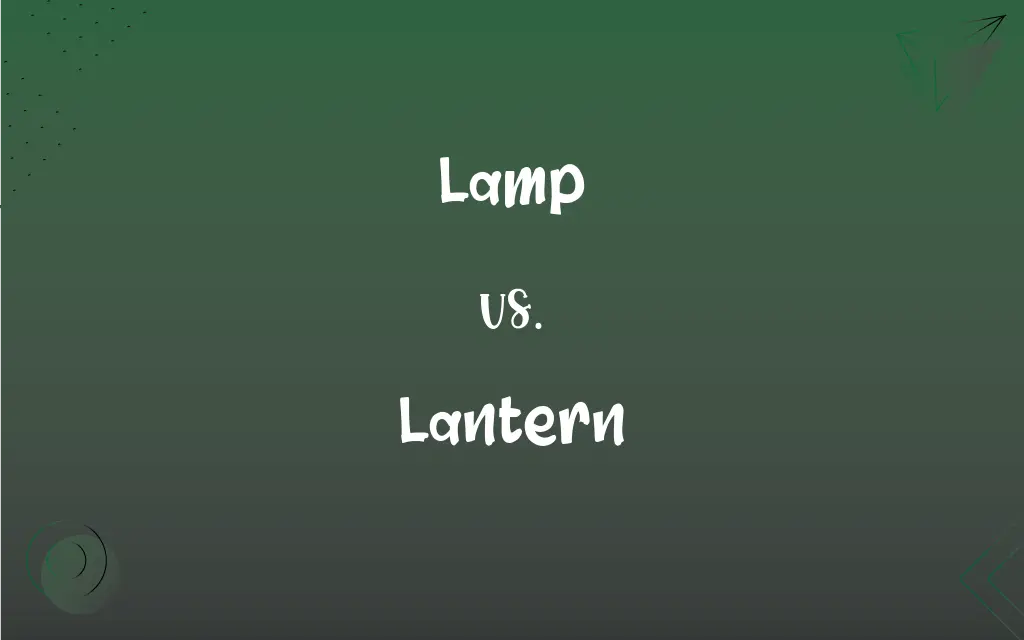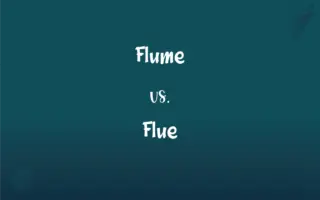Lamp vs. Lantern: What's the Difference?
Edited by Harlon Moss || By Janet White || Updated on July 8, 2024
A "lamp" is an electrical or oil device that emits light, often for indoor use, while a "lantern" is typically a portable light source with protective casing, used outdoors.

Key Differences
Both "lamp" and "lantern" serve the primary purpose of providing illumination. A "lamp" is typically associated with stationary lighting solutions, often used indoors. It can range from desk lamps, table lamps, to tall standing lamps. These are frequently electrically powered, but historically, some lamps used oil or gas. On the other hand, the essence of a "lantern" is its portability and protective design. Often used outdoors, a "lantern" comes with a protective casing that shields the light source from elements like wind or rain.
While both "lamp" and "lantern" can be aesthetically pleasing, a "lamp" often leans more towards decorative design. Many households or offices use lamps not only as light sources but also as decorative elements that complement the interior design. In contrast, the design of a "lantern" focuses more on functionality, ensuring the light source remains protected and the device is easy to carry.
In terms of technology, a "lamp" often offers more advanced features, such as adjustable brightness, color temperature controls, or smart integrations. A "lantern," however, prioritizes ruggedness, durability, and often features handles or hooks for hanging.
Comparison Chart
Primary Usage
Often stationary and indoors
Portable and typically outdoors
Power Source
Electric, oil, or gas
Battery, candle, or oil
ADVERTISEMENT
Design Purpose
Decorative and functional
Functional with protective casing
Modern Technological Features
Adjustable brightness, smart controls
Ruggedness, durability, hooks for hanging
Historical Origin
Oil or gas-based lighting solutions
Protective devices for candles or oil-based lights
Lamp and Lantern Definitions
Lamp
A device emitting light from electricity, oil, or gas.
She turned on the lamp to read her book.
Lantern
A historical tool using candles or oil for illumination.
The old-fashioned lantern cast a warm, soft light.
ADVERTISEMENT
Lamp
An electric bulb holder typically used for reading or decor.
The designer lamp added a modern touch to the space.
Lantern
A portable device emitting light with a protective casing.
She carried a lantern during the night hike.
Lamp
A fixture providing illumination indoors.
The ornate lamp complemented the room's décor.
Lantern
A light source often used outdoors or for camping.
The lantern's glow lit up the campsite.
Lamp
An electric device having a socket for a light bulb, especially a free-standing piece of furniture.
Lantern
An enclosed light source with transparent or translucent sides.
The storm lantern protected the flame from the wind.
Lamp
A device that gives off ultraviolet, infrared, or other radiation, used for therapeutic purposes.
Lantern
An often portable case with transparent or translucent sides for holding and protecting a light.
Lamp
A light bulb
A spotlight fitted with a metal-halide lamp.
Lantern
A decorative casing for a light, often of paper.
Lamp
A vessel containing oil or alcohol burned through a wick.
Lantern
A light and its protective or decorative case.
Lamp
A lantern or fixture that gives off light by burning gas, usually by means of a mantle.
Lantern
The room at the top of a lighthouse where the light is located.
Lamp
(Archaic) A celestial body that gives off or reflects light.
Lantern
(Obsolete) A lighthouse.
Lamp
A device that generates heat, light or other radiation. Especially an electric light bulb.
Lantern
A structure built on top of a roof or dome with open or windowed walls to admit light and air.
Lamp
A device containing oil, burnt through a wick for illumination; an oil lamp.
Lantern
A case of translucent or transparent material made to protect a flame, or light, used to illuminate its surroundings.
Lamp
A piece of furniture holding one or more electric light sockets.
Lantern
(theatre) Especially, a metal casing with lens used to illuminate a stage (e.g. spotlight, floodlight).
Lamp
To hit, clout, belt, wallop.
Lantern
(architectural element) An open structure of light material set upon a roof, to give light and air to the interior.
Lamp
To hunt at night using a lamp; see lamping.
Lantern
(architecture) A cage or open chamber of rich architecture, open below into the building or tower which it crowns.
Lamp
To hang out or chill; to do nothing in particular.
Lantern
(architecture) A smaller and secondary cupola crowning a larger one, for ornament, or to admit light.
The lantern of the cupola of the Capitol at Washington, or that of the Florence cathedral
Lamp
A thin plate or lamina.
Lantern
(engineering) A lantern pinion or trundle wheel.
Lamp
A light-producing vessel, device, instrument or apparatus;
Lantern
(steam engines) A kind of cage inserted in a stuffing box and surrounding a piston rod, to separate the packing into two parts and form a chamber between for the reception of steam, etc.; a lantern brass.
Lamp
Figuratively, anything which enlightens intellectually or morally; anything regarded metaphorically a performing the uses of a lamp.
Thy word is a lamp unto my feet, and a light unto my path.
Ages elapsed ere Homer's lamp appeared.
Lantern
(rail transport) A light formerly used as a signal by a railway guard or conductor at night.
Lamp
A device or mechanism for producing light by electricity, usually having a glass bulb or tube containing the light-emitting element. Most lamps belong to one of two categories, the Incandescent lamp (See under Incandescent) or the fluorescent lamp. However, see also arc lamp, below.
Lantern
(metalworking) A perforated barrel to form a core upon.
Lamp
A device that emits radiant energy in the form of heat, infrared, or ultraviolet rays; as, a heat lamp.
Lantern
(zoology) Aristotle's lantern
Lamp
An artificial source of visible illumination
Lantern
(transitive) To furnish with a lantern.
To lantern a lighthouse
Lamp
A piece of furniture holding one or more electric light bulbs
Lantern
Of a facial feature, large and squarish in shape as an old-fashioned lantern.
Lamp
An object used to produce light and sometimes heat.
The old oil lamp flickered in the corner.
Lantern
Something inclosing a light, and protecting it from wind, rain, etc.; - sometimes portable, as a closed vessel or case of horn, perforated tin, glass, oiled paper, or other material, having a lamp or candle within; sometimes fixed, as the glazed inclosure of a street light, or of a lighthouse light.
Lamp
A source of artificial light.
He switched off the lamp before leaving the room.
Lantern
An open structure of light material set upon a roof, to give light and air to the interior.
Lantern
A lantern pinion or trundle wheel. See Lantern pinion (below).
Lantern
A kind of cage inserted in a stuffing box and surrounding a piston rod, to separate the packing into two parts and form a chamber between for the reception of steam, etc.; - called also lantern brass.
Lantern
A perforated barrel to form a core upon.
Lantern
See Aristotle's lantern.
Lantern
To furnish with a lantern; as, to lantern a lighthouse.
Lantern
Light in a transparent protective case
Lantern
A device with a handle, often used in festivals or events.
The paper lanterns floated beautifully in the sky.
FAQs
Can lanterns be used indoors?
Yes, while typically portable and outdoor-suited, lanterns can be decorative indoor pieces too.
Is a lamp always stationary?
While lamps are often stationary, some designs are portable and battery-powered.
Are all lamps electrically powered?
No, while many modern lamps are electric, historical lamps used oil or gas.
Do lanterns only use candles?
No, lanterns can use candles, oil, or modern ones may use batteries.
Can lanterns be hung?
Yes, many lanterns come with handles or hooks for hanging.
Can a lamp be used outdoors?
While lamps are typically indoor fixtures, some outdoor-specific designs are weatherproof.
What is the primary purpose of a lantern's casing?
A lantern's casing protects the light source from external elements like wind or rain.
Are lamps primarily decorative?
While many lamps serve decorative purposes, their primary function is illumination.
Are all lamps tall and freestanding?
No, lamps come in various designs, including table lamps, desk lamps, and floor lamps.
Do modern lamps offer adjustable brightness?
Many modern lamps allow users to adjust brightness and sometimes even color temperature.
Are there lanterns that can be floated in water or air?
Yes, some lanterns are designed to float on water, and others, like sky lanterns, can be released into the air.
What's a common material for traditional lantern casings?
Traditional lanterns often used glass or transparent paper as casing material.
Are lanterns only functional?
No, many lanterns are decorative and used in festivals, events, or home décor.
Are lanterns safe for indoor use?
While many lanterns are safe indoors, it's essential to ensure adequate ventilation if using oil or candle lanterns.
Can a lamp also be a work of art?
Absolutely, many lamps are intricately designed and serve as decorative art pieces.
About Author
Written by
Janet WhiteJanet White has been an esteemed writer and blogger for Difference Wiki. Holding a Master's degree in Science and Medical Journalism from the prestigious Boston University, she has consistently demonstrated her expertise and passion for her field. When she's not immersed in her work, Janet relishes her time exercising, delving into a good book, and cherishing moments with friends and family.
Edited by
Harlon MossHarlon is a seasoned quality moderator and accomplished content writer for Difference Wiki. An alumnus of the prestigious University of California, he earned his degree in Computer Science. Leveraging his academic background, Harlon brings a meticulous and informed perspective to his work, ensuring content accuracy and excellence.































































